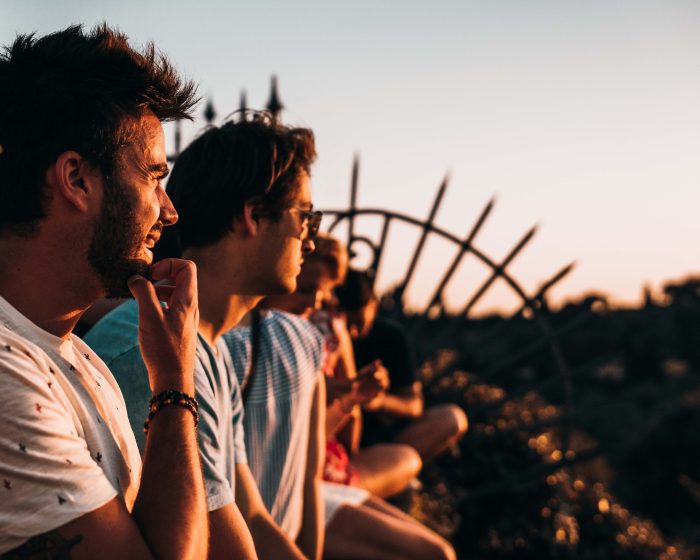A tool we can use to get along better
I just published my new book, How To Die Happy. As a longstanding fan and contributor to Elephant Journal, I’d like to share one of the chapters with you. This is from Chapter Thirty-Nine: The Jungian Archetypes. I hope you find some resonance with these words.
I don’t like that man. I must get to know him better. ~ Abraham Lincoln
The primary reason we fall out is miscommunication. We clash because we assume what people are thinking rather than simply asking. Or we expect them to be like us and are disappointed when they are themselves. We regularly fail to appreciate our differences. How do we fix this? Understanding others’ values and motivations means we can better comprehend their feelings and actions alongside our own.
Through observation, we seek resonance. Given our intrinsic connection and the occasionally inconvenient necessity for us to interact, we do well to adopt the study of humans and their personality traits. We can embody and share multiple personas at any time in this life or the next. So whether you’re on a mission to become someone or no one, there’s an argument for learning more about everyone. Friction comes easily in this age of separation, while harmony is borne from empathy.
This is where profiling, like the Myers-Briggs, DISC, or Personality Shapes, and the more esoteric Human Design models come in handy. Some might give off a faint corporate whiff. Still, they’re legitimately practical tools to help us better understand the various facets of humanity.
We’ve already discussed C. G. Jung’s concept of Individuation. For this chapter, we’ll focus on the Jungian Archetypes, thus dipping our toe into the collective unconscious. The twelve Archetypes represent milestones in our personal development journey. Brand strategists still use them today, instrumental as they are for isolating and humanising a brand’s personality. It’s not uncommon to see a combination of two or possibly even three Archetypes in one individual. For example, the Jedi Master Obi-Wan Kenobi displays blended traits of the Hero, Magician, and Sage.
Jung’s Archetypes were partially inspired by Pluto’s Forms, and you can lose days, even weeks diving into the tomes of psychobabble written on this thinking. I’m keen to keep my observations breezy in comparison. Similarly to Jung’s assertion that our substantial appreciation for the Hero’s Journey is genetically inherent, the Archetypes belong to our collective unconscious as an imprinted, inherited aspect of the human psyche.
Perhaps the Creator’s brief to Self went like this:
“I’m making a multi-generational holographic game of learning in a giant, round, green and blue school designed to last for aeons. I’ll leave subtle trace code in the game players’ collective unconscious psyche. Every time they find the Easter eggs inside the game, they unlock special abilities and level up.”
The Archetypes comprise knowledge and experiences shared by humans, personified by twelve characters collectively representing us and our various personas. So if this stuff is hard-coded into our DNA, one has to wonder how and to what end?
Jung created the original Archetypes, but they saw a renaissance in 2001 when Margaret Mark and Carol Pearson published The Hero and The Outlaw: Building Extraordinary Brands Through the Power of Archetypes. Here, the Archetypes had a 21st-century overhaul, making them altogether more accessible to the layperson.
Associated with the Archetypes are four cardinal orientations, essentially four drivers underlying three archetypes each. The drivers are:
Ego (to be seen, heard, admired). Order (to maintain structure within societal situations). Social (to cultivate meaningful connections). Freedom (yearning unrestriction from one’s limits).
As you can see from the illustration, three Archetypes are driven by Ego, three by Order, three by Social, and three by Freedom.
A brief summary of the twelve looks like this:
- Innocent (Freedom).
- Sage (Freedom).
- Explorer (Freedom).
- Outlaw (Ego).
- Magician (Ego).
- Hero (Ego).
- Lover (Social).
- Jester (Social).
- Everyman (Social).
- Ruler (Order).
- Caregiver (Order).
- Creator (Order).
Innocent
A mystic, romantic dreamer, the Innocent seeks happiness through rose-tinted glasses. Oblivious to the world’s dangers, they float through life with a delightful sense of naivety. Optimistic and understanding right and wrong, they’re keen to avoid punishment on the road to utopia. However, overindulgence can distract them from society’s realities and dangers.
Sage
The Sage knows there is freedom in truth. Valuing knowledge, peace, and wisdom in equal measure, the Sage welcomes learning to help make sense of the world. Objective and thoughtful, the Sage researches, plans, philosophises, and mentors. They may study forever without putting learning into action. The Sage can appear to lack empathy, perhaps due to their evolved love of logic and an established understanding of suffering.
Explorer
The Explorer is always on the lookout for the next adventure. The Explorer searches far and wide for fulfilment but can be aimless and ungrounded. Fiercely independent autonomists, staying true to themselves, can appear self-centred. They remain ever keen to escape feeling dissatisfied or forced to conform. As Explorers seek to understand themselves through travel and experience, freedom is their everything.
Outlaw
Fearing powerlessness, the Outlaw is a misfit who shuns conformity in favour of chaos and occasional destruction. A reinventor of wheels, the Outlaw spits in the eye of rules and regulations that suit them not. Disruptive and inventive, the Outlaw challenges the status quo, inciting a riot to create meaningful change. Wild as they are, we agree with their ideas yet lack the courage to express this.
Magician
Magicians are visionaries, inventors, and healers. Alchemists, by nature, they create beautiful connections through charisma and conversation. The Magician understands the mind and the world’s ways and thus can make things happen. They seek transformation in themselves and others. Magicians strategise and stick to their vision, constantly keen to find an accord. With this skill set comes the risk of deception and manipulation to meet their goals.
Hero
Crystal clear on what’s “right” and “wrong,” the Hero defends, beating injustice with a stick. Obstacles and challenges are welcome ways for the Hero to define their character. Heroes often become rescuers, focused on helping others, whether requested or not. Thus, the Hero can also be controlling—narcissistic even, as their accomplishments feed the ego in real-time. Strength, competence, courage, and arrogance play a tug of war in the Hero’s head. This warrior and winner likely fears vulnerability; gutsy or not, such uncharted territory is unwelcome.
Lover
The flames of passion, romance, and lust are fanned daily by the Lover as they seek to imbibe the associated emotions of bliss and adoration. Though flinging themselves into love as they do, the Lover often objectifies others while having little understanding of true intimacy. Keen for affection, the Lover may also struggle with silence or solitude. Their inclination towards people-pleasing may mean they lose their sense of Self. Though they seek romance, a Lover can make an enthusiastic friend.
Jester
Hedonistic, full of beans, often silly and fun, the Jester lives from one moment to the next and will sleep when they die. The Jester is the breeze in a stuffy room, capable of raising the energy of the flattest crowd. Boundless enjoyment drives them, but their lacking self-control can cause chaos, and they rarely accept responsibility. Prone as they are to distraction and feast, a Jester can often fall foul to addiction. Burning bright as the Jester does, they risk exhaustion and depression. Who will be present for this event? What lies behind their energetic mask of frivolity?
Everyman
Fitting in to feel secure drives the Everyman to seek loyalty, tradition, and the safety of the comfort zone. The Everyman is happiest as a crowd member, made anxious by compulsion and spontaneity. Frictionless societal membership works very well (thank you) for the Everyman. No need for revolution if things work “just fine.” Connection and belonging are as crucial as realism and simplicity. In their effort to conform, the silent majority risks missing out—keen as they are to blend in.
Ruler
Order is the order of the day for the Ruler, which they seek to impose with rigidity and control. Structure is vital, supporting much productivity. A Ruler fears chaos or losing power while nurturing responsibility and leadership. While a Ruler’s heart may be in the right place, their communication skills and authoritarian nature can often cause unnecessary friction. Controllers and expert planners, spontaneity is not the Ruler’s way.
Caregiver
Driven by self-sacrifice, the altruistic Caregiver is inclusive and compassionate. Generous and dedicated, they give seemingly not to receive. Codependency often motivates Caregivers; thus, they tend not to protect their boundaries. Caregivers can often be rescuers, likely to become victims of another’s Drama Triangle. Therefore, exploitation usually follows. Helpful, supportive, and loving, the Caregiver puts everyone else first.
Creator
Ideas and projects are the Creator’s lifeblood. Natural generators, they manifest dreams with drive and determination. Though, with so many ideas, resistance is the Creator’s number one enemy. Creators have multiple projects in play. Hence often, their projects never see fruition. Creators are masters of expression through a selection of mediums. While their perfectionism is often exhausting, their creativity and imagination inspire.
Heroes on Journeys
All great stories contain characters like this; they are inherently relatable. Who, from your life, could you immediately see as one or a mix of these personalities? And since this book is all about self-inquiry, which are you? As with all personality profiling, there’s a danger of pigeonholing, and it’s worth noting also that our characters can change as we grow. Martin v1.0 was part Jester, part Magician, part Outlaw, with a wounded subset slice of the Innocent child. Not anymore. We wanted to change, so we did.
Imagine combining adventure with innocence, selflessness with love and a lust for life, courage, alchemy, and more. We can become every one of these Archetypes. In choosing to do so, we invite the most fulfilling life experience. Many dare not dream of the gift of collective learning in a single lifetime, yet it remains a possibility.
The Hero’s Journey follows a long and winding road, so collision avoidance is advantageous. Suppose you recognise personality traits linked to an individual’s needs. In that case, you can more appropriately engage with them on their level, softening, elaborating, or trimming your communication style to better suit theirs. As same as we are, we’re not all the same. So, we must learn to look past someone’s surface-level behaviours. Consider them an iceberg, with us often only seeing the tip. What mass of experience and emotions lies in their depths? What trauma steers their words and deeds, perhaps beyond their control? Why are we the way we are? There’s always a reason—a pathology—and taking the extra step to consider it puts us in good stead to better interact with more depth and meaning, empathy, and compassion.
As we plough headlong into a future of screen and VR-based relationships hiding behind avatars in a virtual world, human communication as we know it might become a lost art. Though ironically, an avatar in itself, ego already stands between us and breaking this down to find common goals is challenging enough for many. Whether digital or mental façade, underneath, we remain humans with trauma, vulnerability, feelings, and beautiful idiosyncrasies to be observed, navigated, and enjoyed.
All rights reserved
Copyright © 2023 Martin O’Toole
~
Please consider Boosting our authors’ articles in their first week to help them win Elephant’s Ecosystem so they can get paid and write more.


 Share on bsky
Share on bsky





Read 5 comments and reply